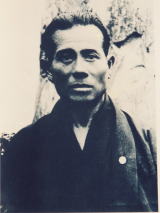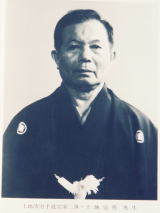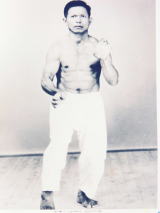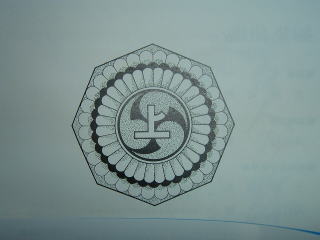沖縄上地流唐手道保存会設立趣旨
沖縄上地流唐手道保存会は、1996年4月1日付けで上地流唐手道
開祖上地完文先生及び上地流唐手道宗家二代目上地完英先生を崇拝
し、その教えを忠実に守り、上地流唐手道の型を永久不変なものとして
改変することなく継承し、普及発展させることを目的に設立した組織であ
る。
The Okinawa Uechi ryū Karatedo
Preservatin Society was established in April 1,
1996 to preserve and protect faithfully the teachings
of the founder Uechi Kanbun
Sensei
and the second generation Soke Uechi Kanei,Sensei his son. The Organization has inherited without modification
the Uechiryu system and was established with thepurpose of allowing its widespread development
| 上地流唐手道開祖上地完文先生
明治43年中国福建省から沖縄県へ
上地流唐手道を伝えた
1910: Moved from Fujian,China to Okinawa Prefecture
Uechi Ryu Karatedo founder Uechi Kanbun
sensei
1910: Moved from Fujian,China to Okinawa Prefecture
Taught Uechi Ryu Karatedo
|
 |
上地流唐手道宗家
二代目上地完英先生
Uechi karatedo
Soke
|
 |
上地完英先生の虎の構え
Second generation Uechi
Kanei sensei
Uechi Kanei sensei in tiger stance
|
 |

上地流の歴史
上地完文先生を開祖と仰ぐ流派で、源流は、中国福建省福州市在
の南派少林拳にある。上地完文先生は、1897年(明治30年)から1
3年間にわたって周子和に師事し、免許皆伝となり、帰国後の1926
年(大正15年)和歌山市に道場を開設した。1932年(昭和7年)に
道場名をパンガイヌーン流唐手術研究所とし、伝授を本格化する。19
40年流派名を沖縄上地流と改める。以後特に終戦後、上地流は実
戦的な武道として声価をとみに高める。技法上の体型は、中国古来
の三戦(サンチン)、十三(セーサン)、三十六(サンセイリュウ)などの
三つの型を基軸として戦後編み出された完子和(カンシワ)、完周(カ
ンシュウ)、十戦(セーチン)、十六(セーリュウ)、完戦(カンチン)の五
つの型に、組手を加えて完成された。
The History of Uechi Ryu
The Uechi Ryu School of Karate was founded by Uechi
Kanbun sensei but its originscan be traced to the Southern Style Shorinken School
in China ‘s Fuzhou City,FujianProvince.Uechi Kanbun sensei trained for 13 years from1897(Meiji30)and
following his being granted full mastership he returned to Japan
in 1926 and opened his dojo inWakayama City. In 1932 , the dojo was named Pangainoon
Karate Institute and was set up to provide formal instruction. The name of his school of karate
was again revised to Okinawa Uechi Ryu in 1940. Ever since, and especially after the end of the war,the Uechi Ryu School of Karate began to acquire its reputation and high appreciation
as an actual fighting martial art.
Its body of
kata echniques initially comprised
the aditional Chinese
kata Sanchin, Seisan, and
Sanseiryu but after the war
the following five kata Kanshiwa, Kanshu, Sechin, Seryu,
Kanchin and kumite were added
上地流の特徴
中国の斯道権威筋は沖縄上地流の拳質を龍虎鶴の拳と鑑定するが
、技法上の特性はこの三種の動物の攻防と原理を体系化したことに
ある。
練習体系では、技理不偏を要諦とし、理前業後(型→組手)の原理
を強調する。
すなわち、型の演練を中心にして、それの応用技としての組手が補
強的に練成される仕組みになっている。その過程で修行者の志向す
るものは心技体合の境地であることは論をまつまでもない。上地流の
道統を思想づけるものは八常の徳、礼儀・信義・廉潔・質素・公正・寛
大・剛毅・不屈の意志力であるが、技法的には、眼精手捷が流是とな
っている。
The Characteristics of Uechi
Ryu
Following the Chinese
instructional system whose strike principles centers around
Three animal styles of
defence and attack(that of the Dragon, the Tiger and the Crane),
The Uechi Ryu school of Karate also systemized its techniques on the same
principles
The School’s training philosophy gives equal consideration to
techniques and to the
study of their underlying
principles,emphasizing the study of the principles before the
practice of their
applications(from kata to kumite). In other words , kata remains at the
core of the training
regiment with kumite reinforcing the application of the techniques.
It goes without saying that
the aim of going through this training regiment is to help
the practitioner achieve
the merging of his/her spirit with techniques and a
strengthening of physical
stamina. Uechi Ryu’s spirit can be
summarized in the
following eight pillars:
virtue, manners, integrity, modesty, impartiality, tolerance,
firmness of character and
persistence.
Technically speaking the characteristics of Uechi Ryu are clear piercing
sight and fast
hands.+
簡略するとその特徴としては
1 基本型である三戦の型で①打たれ強い頑健な身体造り、②攻撃技
の修得、③防御技の修得、④敏捷性の修得。
2 小手鍛え、お互いにペアーを組んで小手を叩き合いながら小手を徹
底的に鍛え、究極の目的としては、敵から突きや蹴りで攻撃された場
合に敵の手足を小手で受けて骨を叩き折ったり、敵に痛味を与えて戦
意を喪失させる。
3 攻撃技は、徹底的に手先及び足先を鍛えて、敵の急所である目・喉・
脇腹等を貫手や足先(足の親指を固める)蹴りなどで突き刺すように攻
撃する。
4 受け技は、遠心力を活用し、敵の攻撃を円を描くように回しながら受
ける廻し受け、内ち受、外受けなどである。
5 組み手は、敵からの突き蹴りなどの攻撃を遠心力を活用した廻し受け
等で受けて手足を押さえ込んで即攻撃する。
なお、組み手は、顔面上段は、寸止めであるが、胴体から下部は、直
接当てる極めて実戦的である。
In summary,
1. The basic Sanchin kata aim to (a)
develop a robust body against attacks,(b)teach
strike techniques (c)teach defense techniques (d) enhance agility
2. By pairing up
practitioners to train strengthening the bones against attack
(kotekiae),the ultimate objective of
forging such physical strengthening is so that
the practitioner becomes able to break the
fighting spirit of his or her opponent in
the event of being attacked by kicks or
punches in a real situation.
3. Striking techniques
require thorough training of the fingers and toes to enable
practitioners to be able to strike
forcefully and effectively at their opponent’s vita
parts of the body , such as the throat,
the eyes or the ribs.
4. Blocking techniques require making use of
one’s centrifugal power
so as to draw an
opponent’s attack into a circular blocking movement.
5. Sparring (kumite)focuses on using the body’s centrifugal power to not only counter
an opponent’s attack using a circular blocking movement but to also strike back
immediately by first immobilizing the
opponent’s arms and legs. Furthermore,
while kumite training stops short of
actually striking the upper face area, it does
require directly hitting the lower parts
of the body (below the torso) and is thus a
very effective, real fighting practice.
このページのトップへ↑
|





